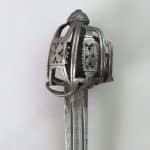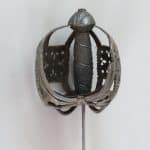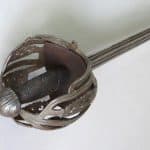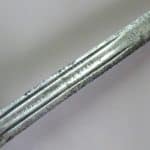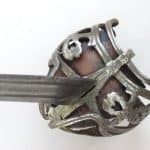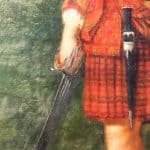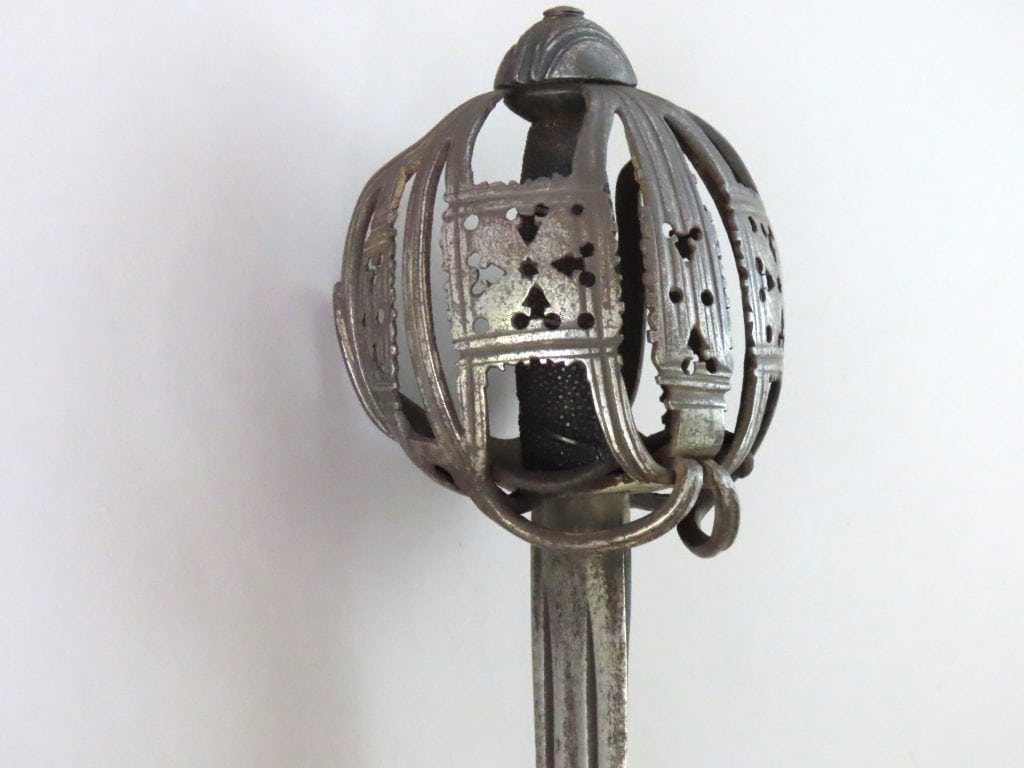
A Late 17th Century Scottish Basket Hilted Sword in the “Glasgow” Style
To enquire about this itemplease click here
Price: £7,500
Ref: AA.15.23
Item Description
A late 17th century Scottish Basket Hilted sword. The hilt is of fine quality workmanship and mounted with a broad single edged blade. The structural bars of the guard are of thick flattened rectangular section. These are decorated on the outside with broad filed longitudinal grooves along the middle with narrower incised lines on either side in what has become known to historians as the distinctive “Glasgow Style” of hilt decoration. The sword has a consistent dark russet patination across its parts.
This style was developed by sword makers in Glasgow in the second half of the 17th century and flourished until the third quarter of the 18th century. The style was adopted by the most skilled smiths in other sword making centres in Scotland and was also copied by the British military for some of its own basket hilted swords made in the Scottish style in the mid-18th century. Filing and incising the bars in this manner was a time consuming and skilled task demanding many hours of work and reserved only for the best and most expensive hilts.
The primary guard panels at the front of this sword are decorated with a pierced seven pointed star at the centre, surrounded by pierced triangles enhanced with circle shapes at the sides and circles in the corners. The narrower side guard panels and the knucklebow are pierced with similar shapes. The main guard panels are filed in “Glasgow” style at the sides. The side guards are filed the same across the top and bottom and the knucklebow across the base. These three secondary panels are enhanced with vertical lines. All five of the primary and secondary guard plates are fretted at the edges with cusps and merlons. The side panels have structural solid merlons mounted at the base with the flattened ends filed with cusps and pierced with flanged hearts. The forward loop guards are decorated in the “Glasgow” manner, and underneath, the cross bar is enhanced with a cut loop which surrounds the groove made to accommodate the blade into the hilt. The sloping rear quillon is decorated with a cross.
The upper surface of the rear quillon has a piece of metal attached to the bar by two rivets. The rear quillon of early basket hilts like this one was not mounted with a scrolled wrist guard which is a later feature in basket hilt development. It seems that in the later working life of the sword an attempt was made to attach a wrist guard to the hilt which was only partially successful having been broken off at some point leaving the riveted stump behind.
The basket has been intentionally forged to appear slightly asymmetrical when viewed from the front and back, with the basket appearing swollen more to the right compared to the left, indicating that the hilt was made for a right hand user. The swollen side of the hilt accommodates the fingers of the right hand whereas the opposite side needs only to accommodate the thumb which takes up less space inside the hilt.
The dome shaped pommel has a ribbed button on top from which three sets of triple grooves radiate to the edge in the same “Glasgow” manner. The spaces between are cut with similar grooves in crescent shapes. The guard arm terminals tuck securely into a groove cut around the lower part of the pommel in the Scottish style. The associated grip is formed with a spirally grooved wooden core, is covered with shagreen, bound with flattened silver wire and is mounted on a thick leather liner.
The tapering single edged blade is 31.75 inches long (81 cm) and just under 1.75 inches (just over 4.25 cm) wide at the ricasso which is 1.25 inches long (just over 3 cm) and has fullers on each side just inside from the edges. It was most likely made in Solingen in Germany.
From the end of the ricasso a shallow central fuller extends for 8 inches (20 cm) flanked by narrower well defined grooves. The middle fuller on both sides is stamped with the blade smith’s mark of “ANDRIA FERARA” spaced by quatrefoils of dots. Beyond the end of the fullers on each side is an incised orb and cross mark which retains some of the original copper inlay on one side. It shows evidence of a lot of use and sharpening on the cutting edge.
The blade was originally double edged and broader than it is now at around 2 inches (5 cm) wide at the hilt. It dates to the mid to late 17th century. It was intentionally ground down all along one side during its working life to create a back edge by removing around half an inch of blade width at the ricasso and a proportionate amount down to the tip. The three fullers are now not running along the middle as would be usual with a broad sword blade of this type, but instead are nearer to the regressed back edge than the cutting edge as a result of the modification. The groove underneath the hilt designed to accommodate and secure the ricasso has vacant space at the back edge which previously would have been occupied by the blade width now shaved away.
During the early 18th century “back sword”, or single edged, blades became increasingly common. They were less expensive to make than double edged blades and became fashionable for both clan, civilian and military markets in Scotland. The blade may have been slimmed to suit the new fashion. But it is more likely that the sword was damaged and refurbished at some time which involved smoothing deep nicks out of the front of the blade, which absorbs most contact when in use, to create a back edge, then reversing the blade in the hilt. The altered blade gives a slightly unbalanced profile in that the blade front edge now appears to be positioned more forward towards the loop guards than is usual for the profile of a basket hilted sword mounted with an unaltered broad sword blade. There is a repair to the top of one of the guard bars at the pommel which may have been carried out at the same time.
Swords with amended blades of this type, with similar profiles, are not unusual judging by the number that have survived. The famous portrait of Lord George Murray, Prince’s Charles’s Lieutenant General in the Jacobite Army in the 1745 Rebellion, seems to show Murray armed with a sword mounted with a similarly altered blade, as can be seen by the position of the fullers relative to the cutting edge. See the photos below.
The overall length of the sword is 37.5 inches (just over 95 cm). For swords with similar hilts see Cyril Mazansky, “British Basket-Hilted Swords”, Boydell Press, 2005, particularly some illustrated in pages 107 to 126.






